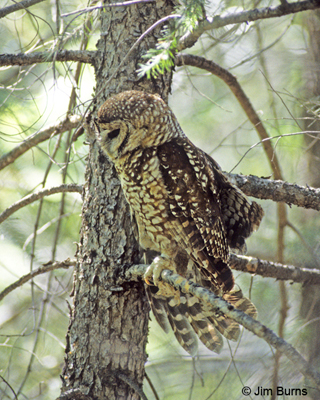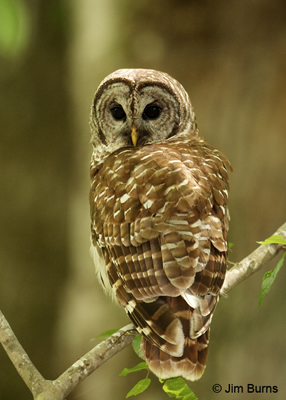
It all began when researchers discovered the main reason for the owl’s population decline was its narrow thermal neutral zone which rendered it highly susceptible to heat stress. Spotted owls needed old growth forest to survive, or so the theory went, and when the bird was placed on the Endangered Species list in 1990, the logging industry got up in arms, quite literally in many cases as loggers with boots on the ground and jobs to protect shot the owls on sight.
As technology replaced trees in a booming Pacific Northwest economy, and high densities of Spotted Owls were discovered in second growth redwood forests of Northern California, things quieted down. Spotted Owls remain, however, the most widely-studied and well-known owl on the planet, and it has become apparent their population decline continues, still at the “hand of man” though only indirectly, and guns will probably be involved again.
Spotted Owl is Strix occidentalis. Barred Owl, Strix varia, its congener, was confined to the forests east of the Mississippi for eons, then apparently spread across the plains of Canada following the rivers bottoms and shelterbelts planted by homesteading farmers, ultimately expanding into Pacific Northwest Canada. When we lived in Seattle in the late ‘70s, Barred Owls had been documented in Washington only a handful of times, so few that listers were neither looking for them nor finding them. Today their range engulfs that of Spotteds and is still expanding southward in California.
Barred Owl is, in one sense, an invasive species in the Pacific Northwest, and it presents a perfect storm for the survival of the Spotted Owl there: Barreds are larger and more aggressive than Spotteds, out competing them for territories; Barreds reproduce more rapidly and have a higher nestling survival rate; Barreds tolerate a much broader ecological niche; Barreds are known to kill and eat Spotteds; Barreds and Spotteds are known to breed and reproduce “Sparred Owls” which are capable of reproduction. Gene swamping, then, may be the most subtle yet most devastating facet of this invasion.
The U.S. Fish and Wildlife Service in Portland has a plan to halt this invasion. Beginning this fall they are going to shoot 3600 Barred Owls in Washington, Oregon, and California. This latest battle in the Owl Wars is sure to be as controversial as the original. I can’t tell you where I stand on this issue because I haven’t thought it thoroughly through yet, but get used to the whole concept because global warming is going to be the catalyst for the expansion and loss of the historic ranges of countless species.
If the plan fails, we have probably lost the two northernmost subspecies of Strix occidentalis. Be thankful you live in Arizona where the third and last subspecies survives, by virtue of geology, in the Huachucas. But . . . if the plan is a success . . . that may well be the most controversial outcome. We cannot turn back the hands of time. If the Spotted Owl’s survival in the Pacific Northwest correlates to the culling of the Barred Owl there, will we still have the will to turn back the hands of man? The Warren Zevon classic, Send Lawyers, Guns, and Money, is playing in my head.